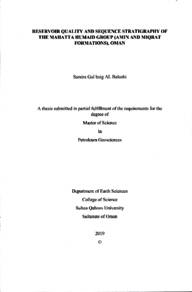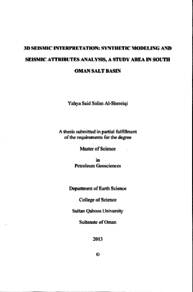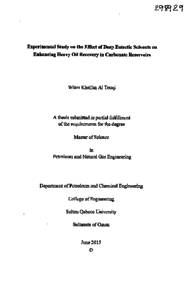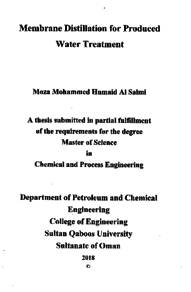وثيقة
A water coning correlation for an Omani fractured carbonate reservoir : a case study
الناشر
Sultan Qaboos University
ميلادي
2009
اللغة
الأنجليزية
الملخص الإنجليزي
This work aims to develop a reservoir management tool (water coning correlation) for intensely fractured carbonate reservoir in North Oman. The production mechanism is Gas Oil Gravity Drainage (GOGD) with crestal gas injection and dedicated aquifer pump-off wells (water producers). As the field is produced from fracture oil rim through horizontal wells, it is crucial to keep the oil rim fixed and at such depth and thickness so that coning and cusping of water and gas into the oil producing wells is minimal. The key challenge is to control the oil rim and keep it at the desired position and at constant thickness. The aquifer pump-off wells are used to control the fracture oil water contact (FOWC). The oil offtake from the oil rim producers should be balanced with the gas oil gravity drainage rate of the system to avoid gas coning. Currently, the oil rim thickness and position in the fractures network is monitored by running gradiomanometer surveys and locate the fluid contacts (gas-oil contact and oil-water contact) in dedicated observation wells spread-out though the field. These surveys are carried out once a year and they cost a lot. Moreover, the limited numbers of the observation wells make it difficult to know the depths of the fluid contacts in some areas where there is no observation well, An analytical approach using the FOWC from the observation wells and the production data from the oil producers was used to develop a correlation between the produced water rate and the distance from the perforations (open hole) to the measured FOWC. In addition, a conceptual simulation model was built to develop the same correlation for one of the field's sectors. In the analytical approach, water rate/water cut versus distance of well perforations/drainage point to the fracture OWC were plotted for most of the field's oil producers and no realistic correlation could be obtained. Insufficient data points for some wells and improper fractures connectivity between the observation wells and the oil producers were found to be the main constraints. On the other hand, the simulation model results showed that the water cut exponentially increased as the FOWC get closer to the well perforations. The obtained exponential correlation from the simulation model could be divided into two linear correlations; below and above critical coning rate. Therefore, producing the well above the critical coning rate (as the current status for most of the field oil producers) yields a linear correlation between the water cut and distance between the perforations (open hole) and the FOWC. However due to lack of fractures details in the model, this correlation needs further improvement so that it can be used for reservoir management in the real field.
الوصف
Thesis
المجموعة
URL المصدر
الملخص العربي
يهدف هذا العمل إلى إيجاد آلية لإدارة المكامن النفطية (علاقة انخراط الماء) المكمن كربوني متصدع بشمال عمان. آلية الإنتاج هي تصريف الجاذبية للغاز والنفط مع حقن الغاز في قبة المكمن وضخ المياه من خزان المياه الجوفية بما انه يتم إنتاج الحقل عن طريق الأبار الأفقية التي تنتج النفط من الطوق النفطي في الصدوع، فمن الأهمية البالغة الحفاظ على الطوق النفطي ثابت وعلى عمق وسمك بحيث يكون انخراط الماء والغاز باتجاه الآبار المنتجة للنفط أقل ما يمكن التحدي الرئيسي هنا هو التحكم في الطوق النفطي وإبقائه في الموضع المطلوب وبسمك ثابت. في الوقت الحالي تستخدم آبار ضخ المياه الجوفية في التحكم بموضع اتصال النفط بالماء في الصدوع . معدل انتاج النفط من خلال الأبار المنتجة للطوق النفطي يجب أن يوازن مع معدل نظام تصريف الجاذبية للغاز لتفادي انخراط الغاز حاليا ، يتم مراقبة سمك وموضع الطوق النفطي في شبكة التصدعات في المكمن عن طريق تسيير مسوحات انحدار ضغط السوائل وبالتالي تحديد عمق اتصالات السوائل (اتصال الغاز بالنفط واتصال النفط بالماء) في الآبار المخصصة للمراقبة والتي تنتشر داخل الحقل. هذه المسوحات تجرى مرة كل سنة ، و تكلف الكثير من المال. وعلاوة على ذلك ، فإن العدد المحدود لأبار المراقبة يجعل من الصعب معرفة أعماق اتصالات السوائل في بعض المناطق التي لا توجد فيها آبار للمراقبة في هذه الدراسة، تم إتباع نهج تحليلي باستخدام اتصالات النفط بالماء التي تم قياسها من آبار المراقبة وبيانات الانتاج من الآبار المنتجة للنفط لإيجاد العلاقة بين معدل الماء المنتج والمسافة بين ثقوب الإنتاج واتصال النفط بالماء. بالإضافة إلى ذلك ، تم بناء نموذج محاكاة لإيجاد نفس العلاقة لاحد قطاعات الحقل. في النهج التحليلي تم رسم مدل الماء المنتج و نسبة الماء من الجمالي السائل المنتج مع المسافة بين ثقوب الإنتاج واتصال النفط بالماء لمعظم الآبار المنتجة للنفط في الحقل ، ولم يتم الحصول على علاقة منطقية. علم توفر بيانات كافية لبعض الآبار والإتصال غير الجيد للصدوع بين آبار المراقبة والآبار المنتجة للنفط وجد أنها الأسباب الرئيسية من ناحية أخرى ، نموذج المحاكاة أظهر أن نسبة الماء من اجمالي السائل المنتج يرتفع بشكل اسي عند اقتراب اتصال النفط بالماء من ثقوب الإنتاج. ويمكن تقسيم العلاقة الأسية المستنتجة من نموذج المحاكاة الى علاقتين خطيتين؛ أدنى واعلى المعدل الحرج للإنخراط. ولذلك فإن إنتاج الآبار أعلى من المعدل الحرج للإنخراط (كما هو الوضع الحالي بالنسبة لمعظم لمعظم الآبار المنتجة للنفط في الحقل) ينتج علاقة خطية بين نسبة الماء من اجمالي السائل المنتج والمسافة بين ثقوب الإنتاج واتصال النفط بالماء. مع ذلك هذه العلاقة تحتاج إلى مزيد من التحسين حتى يمكن استخدامها لإدارة المكمن في الحقل الفعلي وذلك بسب عدم وجود تفاصيل كافية عن التصدعات في نموذج المحاكاة
قالب العنصر
الرسائل والأطروحات الجامعية







